The performance and health of your tires depend directly on how you take care of them. Once you buy a set of new tires, it's not enough just to wash them and maintain them with lubricants from time to time. While this is also necessary, technical maintenance procedures are equally crucial. I am mainly referring to the wheel alignment procedure that I talked about previously and tire rotation, which I will talk about today.
Unfortunately, many drivers ignore this procedure. As long as the tire rolls smoothly on the pavement, drivers rarely realize that they are subject to continuous stress and constant wear.
So, what is tire rotation and how often should you do it? We will see in this article everything related to this topic. Here we will see how the technicians do this procedure, how long the whole process takes, and how often it is recommended.
Tire Rotation And Its Importance In Tire Health
The process of tire rotation is actually very simple, but it brings enormous benefits. It's about changing the tires with the place. This can take place either on the same axis or between axes.
The point is that while rolling, the tire is subjected to external stresses. The tread is worn in the same area because it is always in the same position.
Once the technician changes the tires between them, their wear pattern reverses, evening the structure and extending the tire's serviceability. If the tire remains in the same position on the axis for a very long time, it develops a sectioned wear. Changing its place on the axis changes the pressure on another area. As a result, the wear becomes uniform.
How Does The Rotation Process Take Place?
Technicians use different schemes to rotate a car's tires. Rotation schemes depend on several factors, including the type of vehicle traction system and the tire design.
Front-To-Rear Rotation
In the case of front-to-rear rotation, the technicians will change the place of the rear tires on the front axle on the same side of the vehicle. The technicians take into account the wear of the tire before making this change. This rotation is viable especially if the tire wear is normal. In addition, this scheme is mainly viable for tires with directional tread.
Forward Cross Rotation
Technicians use this scheme mainly for front-wheel drive vehicles, but this is not a rule of thumb. Forward cross rotation consists of the fact that the front tires move to the back rear, without changing sides. Instead, the rear tires go on the front axle, changing sides. Among other cases, this rotation is beneficial if the rear tires show severe signs of wear. Once they switch sides on the front axle, they even out their wear, minimizing the stress on the same portion of rubber.
X-Pattern Rotation
This scheme is quite popular and universal for all types of cars. The rule is very simple and involves changing the position of the tires in the shape of an "X". In most cases, technicians use it to even out the wear of all tires if all of them show signs of wear and tear.
Rearward Cross Rotation
The same scheme is similar to the forward cross rotation. This time, the rear tires move to the front without changing position. Meanwhile, those on the front axle reach diagonally on the rear axle. In most cases, this scheme is applied when the front tires show more obvious signs of wear than the rear ones. In addition, rearward cross rotation is compatible with rear-wheel, four-wheel, and all-wheel drive cars.
Side-To-Side Tire Rotation
The scenario of this rotation involves changing the places of the tires on the same axis. In other words, the front tires remain in front, only on different sides. The same happens with the rear ones.
How Often Should You Rotate Your Tires?
Tire makers come with specific recommendations regarding the frequency of tire rotation. While the recommendations may differ from one another, the general guideline suggests rotation no less often than every 5,000-7,000 miles regardless of the type of traction vehicle. For safety reasons, we recommend checking the instructions in your driver's manual. Keep in mind that ignoring this procedure is not at all healthy for the condition of your tires.
The thing is that the tire wears out no matter how much you take care of it. Poor quality pavements, additional load, improper tire pressure, or even your bad driving habits - all lead to uneven tire wear. So, visiting a technician once in 5,000 miles is a must if you want them to serve you long and reliably.
Tire Rotation Pros And Cons
The new tires perform well precisely because their tread is well-defined, with well-contoured depths, and very pronounced channels/grooves. In the absence of rotation, the tire is wasted only on a certain portion. Over time, this area becomes increasingly sensitive to pressure, impacts, and heat. Heat is a real enemy of tire integrity, by the way. In addition, all performance aspects suffer detrimental changes, which transforms riding into a poor and unsafe experience.
Increases The Risk Of Hydroplaning
The "healthy" tire has grooves and special channels that evacuate water from its path. The tire with bald tread due to the lack of rotation will glide on the asphalt instead of "cutting" the water away. Thus, drivers are more prone to losing control in wet conditions.
Decreases Traction And Overall Car Performance
The external architecture of the tire is more than an aesthetic design. Due to the tread's components and construction, it "sticks" to the road, increasing longitudinal traction and other aspects of performance. This is especially important in rainy and wintery conditions when the tire has to cope with the large volume of water and snow. A tire with uneven tread is hardly able to cope with such conditions. Learn about the impact of a worn tire on the vehicle's components.
Increases The Risk Of Heat Build-Up
The grooves and channels in the tires also have the role of self-cooling. The rubber generates friction during rolling on the road. The special tread allows air to circulate dynamically, creating a cooling effect and controlling overheating. A tire with a worn tread will accumulate excessive heat that will damage its structure prematurely.
It Dramatically Decreases The Integrity Of The Tire
Areas that undergo excessive wear in the absence of tire rotation become much too thin over time. Any stone or uneven surface increases the risk of a tire puncture. In the worst scenarios, the tire becomes much too sensitive for a possible blowout. This puts the life and health of the driver, as well as his passengers, at risk.
What Are The Benefits Of Timely Tire Rotation?
Tire Rotation: FAQs
Do You Really Need To Rotate Your Tires?
The decision to rotate the tires or not belongs to the driver, after all. But, before making this decision, drivers must know the consequences of ignoring this maintenance procedure. Ignoring rotation leads to premature tire wear. This means that the performance of the tires will decrease significantly, the braking abilities will diminish, and the overall safety degree will drop. In addition, ignoring tire rotation is not at all budget-friendly because the driver will have to get new tires much sooner, as the lack of rotation significantly shortens the service life of the tires.
What Are The Rules For Tire Rotation?
The rotation involves removing the wheels together with the tires and mounting them in a different position. Depending on the wear of the tires and the type of vehicle, the rotation can include various schemes such as the front tires going over the rear axle, and the rear tires going over the front axle. Also, the rotation can take place through the X scheme through which the tires cross between the axles. This maintenance procedure extends the life of the tires and ensures better performance. Specialists recommend that the rotation take place at about 5,000-7,000 miles.
Is It OK to Rotate Tires Every 10000 Miles?
As a general rule, the rotation must take place within the mileage limit of 7,000 miles. Technically, you can rotate the tires at 10,000 miles, but you risk wearing out the tread too much. However, if you are an amateur driver who does not operate your vehicle too often, the rotation at 10,000 miles might make sense. However, it would be good to consult a specialist who will tell you after the tire checkup if it is ok to do the rotation at 10,000 miles or maybe better to do it earlier.
Is It OK to Rotate Tires Without Alignment?
Tire rotation can be done with or without alignment. For safety reasons though, specialists recommend taking a look at the suspension system when rotating tires to make sure there is no misalignment. Every vehicle is constantly subject to potholes hitting and other road damage. So, it is not excluded that the suspension needs alignment. Most drivers do both procedures simultaneously, which we recommend you do as well.
Is It OK to Rotate Tires Once a Year?
We recommend to be guided by the cumulative mileage rather than by the calendar period. During one year, a driver can accumulate 70,000 miles while another barely 3,000 miles. So, the calculation by years is not the most subjective. The experts recommend the rotation between 5,000 and 7,000 miles, whenever these are accumulated during half a year or a year. Most drivers rotate the tires with the oil change, which happens about once a year.
Does Rotating Tires Increase Life?
Absolutely, even if this happens indirectly. Without rotation, the tires will wear their tread unevenly between each other. Consequently, traction will suffer, as will handling and balance. Once the tires start to wear out, the process becomes irreversible and develops exponentially. The rotation helps to even out the wear and maintains the tread depth for proper traction and handling balance. As a result, the tires wear out evenly and at a slower pace, which means a longer service life.
Why Does My Car Shake After Tire Rotation?
Most likely, in addition to torque, your vehicle also needs wheel alignment. Vibrations are a common sign of wrong suspension angles that can be corrected with alignment. Consult a specialist to check your suspension. If you have done the alignment and the vibrations are still present, it is possible that the tires were not balanced properly. Balancing helps to distribute the weight correctly on the tires. This happens by adding small weights to the tires to even out the distribution. Balancing helps to remove minor vibrations following a tire rotation.
Why Trust Us?
The information and reviews provided by Neotires are backed up by specialists and experts in the tire field. The Neotires team aims to educate drivers through validated information, confirmed by professionals, and 100% verified so that they can increase their safety on the road and the performance of their vehicles. We are proud of a large team of passionate enthusiasts, expert mechanics, professional content writers, and top-notch technical testers. They work together to provide quality information that increases the safety and comfort of each driver.
Besides the fact that we sell tires of reputable brands at special prices, we dedicate ourselves to self-development to keep up with the tire industry and its tendencies. In this sense, we have created our own technical center where we test, evaluate, and confirm the quality of the products and services we offer. The more than 5 years of experience in the field is not very much. But it is enough to form a quality-oriented team whose major goal is the road safety of our customers.
Bottom Line
As you can see, the list of disadvantages is more or less equal to that of tire rotation benefits. So, it's up to you to choose the script you want to follow. Rotating the tires once every 5,000 miles certainly ensures uniform wear on their entire surface. Consequently, the structure of the tire is more integrated, which translates into higher performance in various circumstances and conditions.
In addition, the tire will last longer, which means you will save on a set of new tires. Drive safe and schedule your tire rotation procedure!




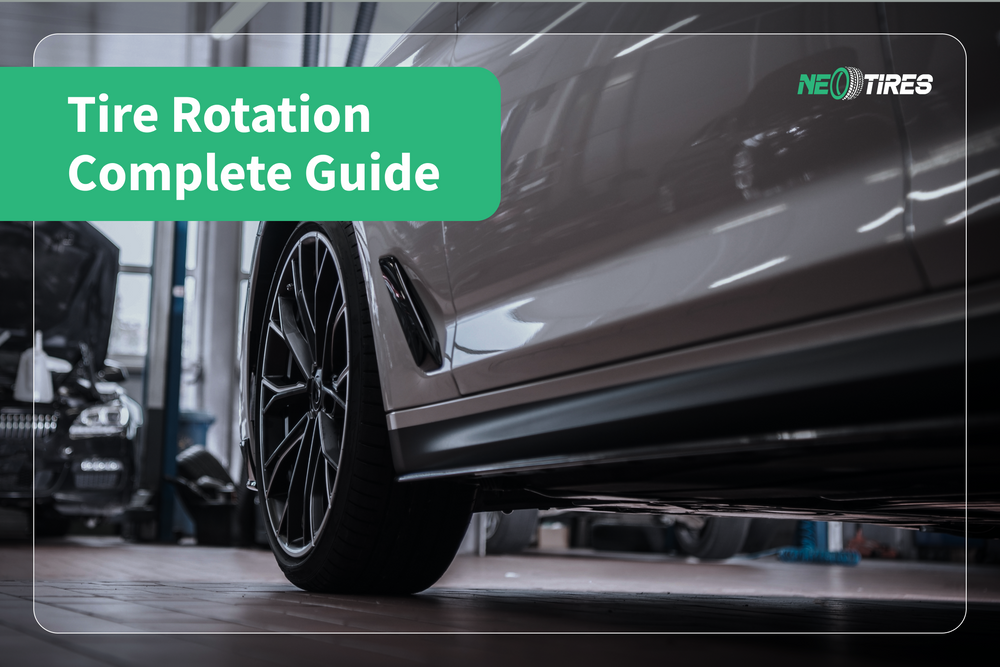
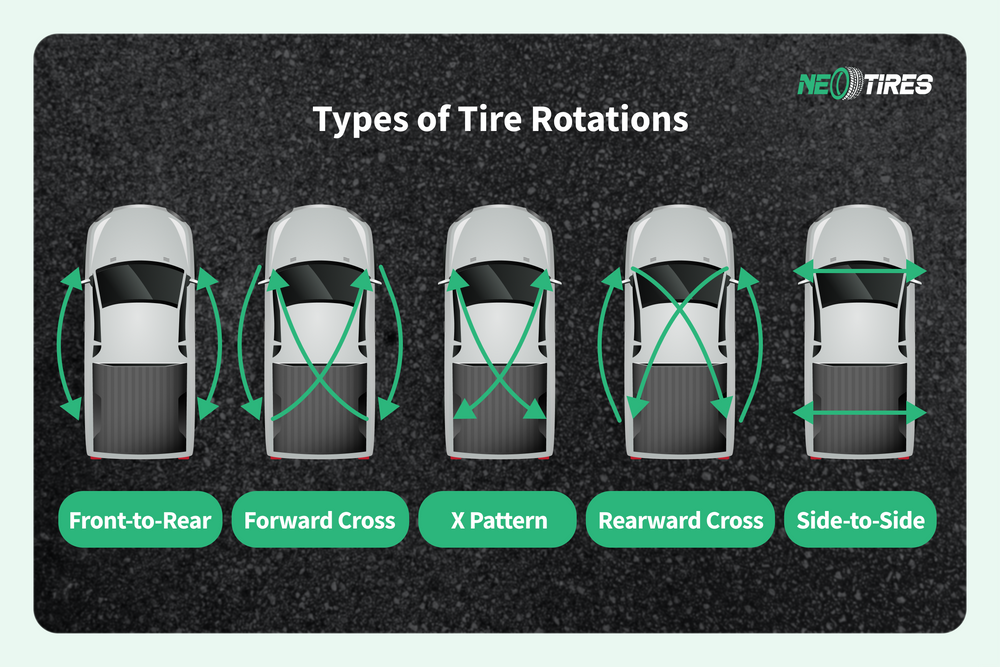
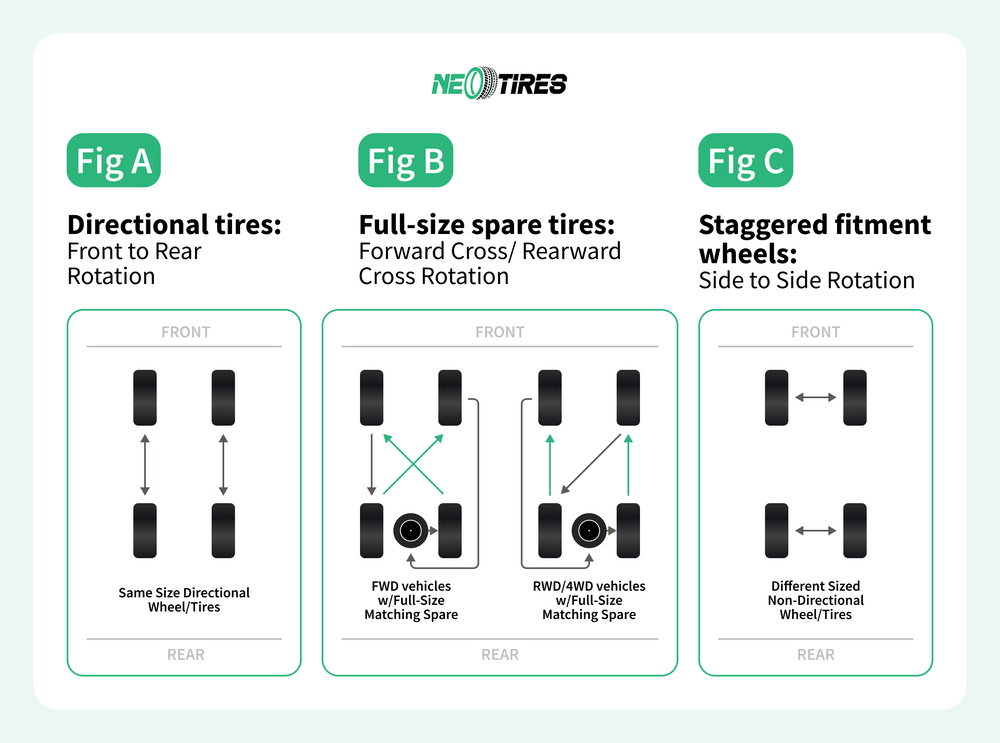
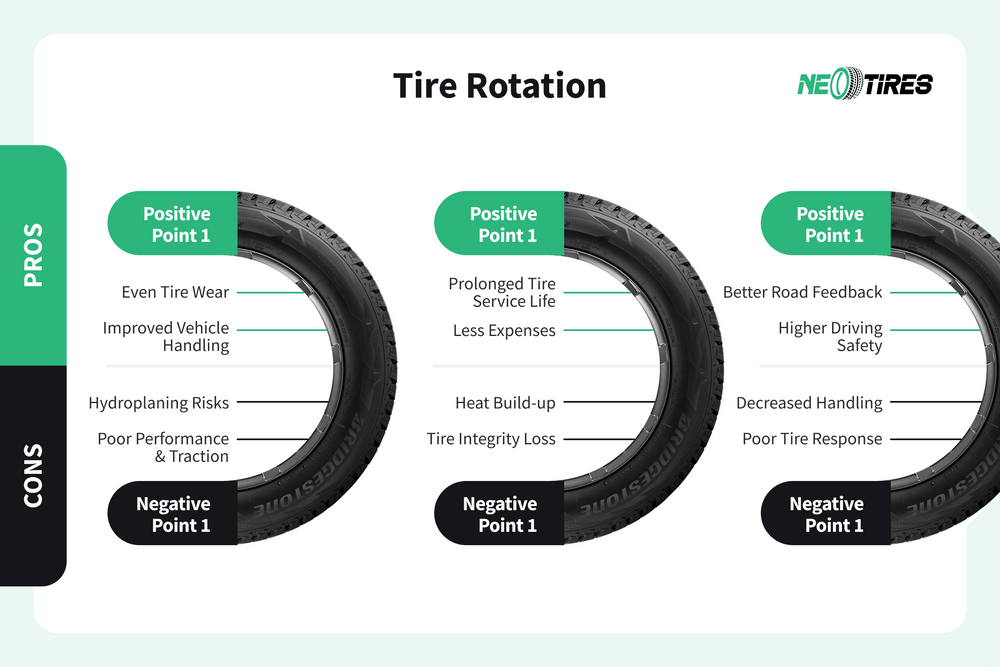
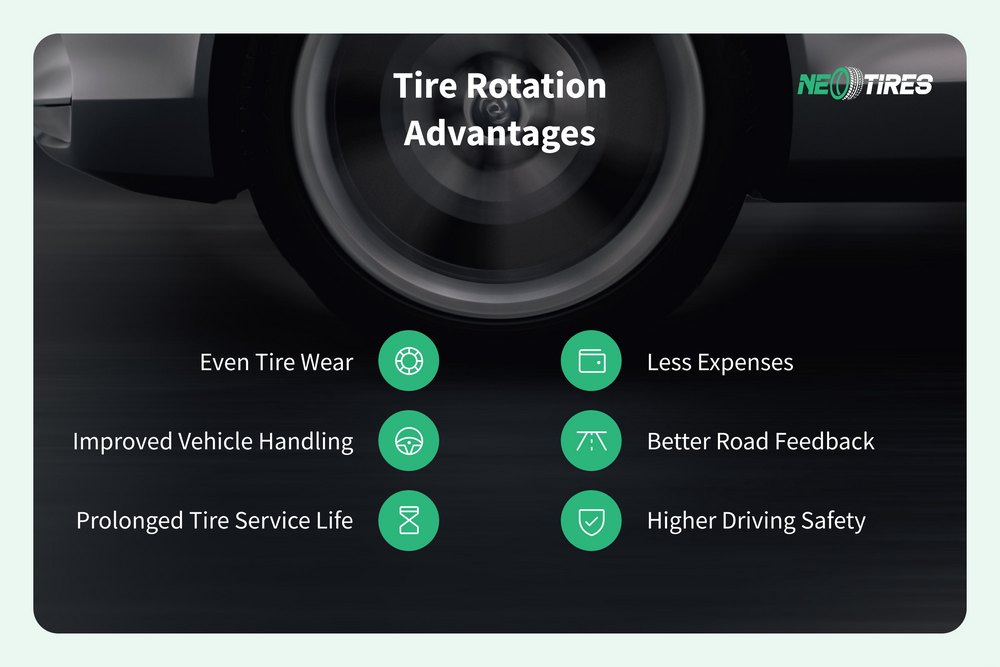


And years ago my tires sore evenly without rotation, if they got the balancing right.
Now, with my 4 wheel independent suspension...not so much. Too many moving parts, stabilizers, rubber bushings...grrr.